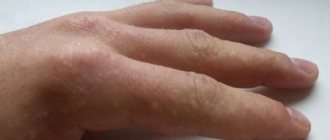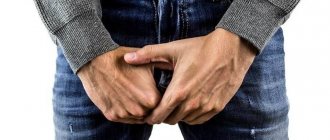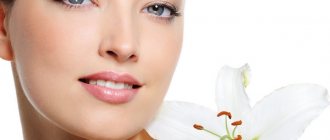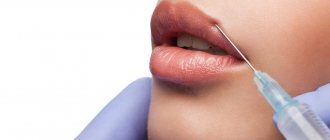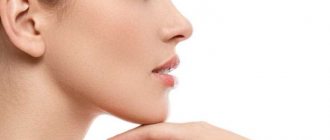Facial pastiness - what is it? The human body consists of 70% water, which is found in the cells of the body and is part of the intercellular fluid. Water helps body tissues remain elastic and elastic, maintaining shape and volume. Sometimes there is a disruption in the distribution of fluid in the body, which entails a disruption in blood supply, proper flow of lymph and intercellular fluid. Then changes occur in a person’s appearance - swelling, pastiness, lethargy and looseness of the tissues of the face and neck increase.
The essence of pathology
The name of this pathological condition of the body comes from Lat. “pasta” means dough, because the signs of this condition make the face puffy and loose, really looking like dough. In a healthy body, the volume, composition and distribution of fluid among tissue cells are all quite balanced and characterized by constancy. The required amount of water enters the tissue cells through the walls of capillaries and small vessels, then also exits back through the blood. Additionally, the outflow of fluid from tissues is carried out by lymphatic vessels.
Sometimes a pathological disturbance in the outflow of fluids occurs, which occurs as a result of thinning of the walls of capillaries and blood vessels, increased pressure in the bloodstream, or an excess of salts - sodium ions. Factors that provoke the appearance of symptoms of swelling and pastiness, that is, accumulation and stagnation of excess fluid in soft tissues, are called provocateurs of swelling.
The development of such a disorder can be caused by various diseases: malfunctions in the immune, nervous and endocrine systems of the human body, dysfunction of the liver, kidneys, diabetes mellitus, pathologies of the cardiovascular and respiratory systems.
Types
Swelling of the skin develops regardless of the time of day and is divided into the following types:
- Heart. It is characterized by a decrease in myocardial activity, which provokes stagnation in the venous channels. Some blood cells penetrate into the intercellular space.
- Renal. As the protein concentration in the body decreases, blood pressure decreases. The fluid penetrates into the surrounding tissue. Sodium and water are retained in the body.
- Inflammatory. With local expansion of the vascular channels, swelling develops and exudate forms.
- Allergic. Upon contact with an irritant, there is a release of mediators that expand the vascular channels and increase the degree of their permeability.
- Cachectic. Develops when there is insufficient protein concentration in food. Liquid penetrates into the intercellular space.
- Endocrine. Occurs when the concentration of thyroid hormones is reduced. Metabolism slows down, sodium and fluid accumulate in the body, and symptoms of pastiness on the face develop.
Signs of facial pastiness
Sometimes boys and girls, and even more so adult men and women, experience some unpleasant symptoms: swelling of the cheeks and neck, puffiness of the eyelids, deterioration of complexion and its “looseness”, sagging cheeks appear, jowls - all these are signs of fluid stagnation and lymph in tissues.
These changes affect not only the face, the outlines of which change significantly, but also the neck - a double chin appears, the lower jaw shifts. Pasty faces look very old, adding decades to their “owner”, and these changes can occur at any age. The places where pastous edema appears directly depend on the anatomical features of the human body, its position and the presence of diseases.
Consequences and complications
With pastosity, the following complications may develop:
- trophic ulcerative foci;
- increase in the area of edema;
- failure of the heart and blood vessels;
- thrombosis;
- spasms of the lower extremities;
- change in skin tone;
- phlebeurysm;
- chronic liver diseases;
- chronic kidney disease;
- hypothyroidism (low thyroid function).
Causes of facial swelling
Most often, manifestations of pastiness can be noticed in the morning on the face and, especially, in the eyelid area, which is explained by the position of the body during sleep (improper distribution of fluid throughout the tissues occurs); the absence of tension in the facial muscles, as well as the fact that the skin in the facial area is less thick and contains a thin layer of fatty tissue. The reasons for the appearance of pastiness, looseness, swelling and laxity of facial tissues can be external and internal processes occurring in the body and outside it:
- Chronic diseases of internal organs and dysfunction of various body systems, in particular diabetes mellitus.
- The presence of allergic reactions in the body.
- The use of certain medications - antidepressants and sedatives, as well as diuretics.
- An unbalanced diet is the consumption of foods lacking proteins, microelements and vitamins.
- Helminthic infestations.
- Menopause in women, premenstrual syndrome, pregnancy.
- Use of low quality cosmetics.
- Smoking, which causes spasm and increased vascular permeability, and drinking alcoholic beverages.
- Long work at the computer.
- Stressful situations, emotional stress, sleep disorders, chronic fatigue syndrome.
- Age-related changes in the body after 35 years, which are accompanied by a sharp decrease in the level of hyaluronic acid in the body.
Pastiness in children
In young children, manifestations of facial and eyelid pastiness are much more common than in adults. Newborns are especially susceptible to this phenomenon, which is explained by dystrophy, developmental anomalies, anemia and lymphatic, exudative diathesis.
Pastiness as a signal of internal diseases
Pastiness on the face, especially in the eyelid area, is a rather unpleasant and alarming signal from the body, indicating a problem in its functioning. When the first signs appear, you should immediately contact a specialist who can determine the true cause of swelling and pastiness on the face and can answer the question: how to remove swelling? After an examination and differential diagnosis, the doctor prescribes a comprehensive treatment that helps eliminate the cause of pastosity and all the consequences of the developing disease. https://www.youtube.com/watch?v=IfPW7fc9l20 [ads-pc-1][ads-mob-1]
How to relieve pain
Traditional medicine treats excess fluid accumulation depending on the cause of its development. Treatment regimens often include • restriction of fluid intake; • reduction of salt and sodium in general; • taking diuretics. All of them have a lot of side effects. Diuretics, for example, can reduce the amount of potassium, which can negatively impact your heart function and make the problem worse.
Osteopathic medicine looks at this differently. The human body is an anatomically and functionally interconnected system. Fascial tissue, which covers all muscles, ligaments and nerves, provides a clear anatomical connection. This connection works at all levels of interaction between organs. An example of such a connection is the “transfer” of a spasm of the diaphragm to the liver, stomach or intestines, which is manifested by colic or constipation.
One of the principles of osteopathic medicine is that structure governs function and vice versa. It becomes more understandable if we consider the displacement of vertebrae or organs. A displaced vertebra (structure) disrupts the functions of nearby and distant parts, leading to excessive mobility and protective muscle spasms to eliminate it. There is a high risk that muscle spasm will compress the veins and tissue around the vertebrae, causing fluid to accumulate.
Osteopaths believe that the central nervous system is at the core of integration. The central nervous system suffers when blood flow, lymph outflow and movement of the bones of the skull are disrupted. These problems impair the functionality of the entire body.
Important points • fluid accumulation can occur as a result of generalized or local processes; • the key causes of generalized processes are heart failure, diseases of the heart or urinary system;
• in case of sudden recoil, you must immediately seek medical help; • fluid accumulation can occur in any area of the body, including the brain; • not all types of swelling are dangerous - sometimes the consequences can be caused only by the reasons for their appearance.
Osteopathic medicine treats the body as a whole. The specialist’s task is to eliminate the resulting spasms and displacements to activate self-healing resources.
Similar articles:
- Directions
- Specialists
- For visitors
- Articles and videos
ONLY UNTIL January 31st!
20% DISCOUNT ON CLASSES ON THE REDCORD SUSPENSION SYSTEM
Classes are conducted by instructor-methodologist Osipova Maria.
REDCORD allows you to eliminate muscle imbalance by relaxing some muscles and stimulating others. This allows you to resume the motor pattern and return the patient to normal functioning!
Treatment, diagnosis and prevention of facial pastiness
Pastosity and swelling have the same symptoms, but different causes of formation. For accurate diagnosis, the McClure-Aldrich test method is used, based on the fact that an isotonic sodium chloride solution injected subcutaneously into the area of noticeable accumulation of fluid is absorbed quite quickly. As a rule, a full examination of the body is prescribed, which helps to identify the cause of the development of pastosity.
In addition to the treatment prescribed by a doctor and carried out in a beauty salon, you can use various methods to remove the pastiness of the face, and especially the eyelids.
After identifying the cause and its treatment, pastiness, swelling and other defects can be cured using special cosmetic procedures, which are selected individually by a cosmetologist.
Treatment at home
One of these methods is self-massage of the face, which can be done in the morning: gentle stroking and tapping with your fingertips in directions from the cheekbones in an arched manner to the lower jaw; from the bridge of the nose parallel to the brow ridges; from the outer corner of the eye to the inner. With this massage, you can use cubes of frozen decoction of various herbs - cold and plant extracts will increase tissue tone and improve blood circulation.
You can use special masks—both those sold in pharmacies and those you make yourself.
- A simple mask of boiled potatoes grated with sour cream, applied for 15-20 minutes on the face and eyelid area in a thin layer, stimulates blood circulation and significantly reduces the signs of pasty skin.
- Decoctions of some medicinal herbs are a diuretic and antiseptic: for example, a decoction of “bear ears” should be taken 2-3 times a day, 2 tbsp. spoons. This decoction relieves swelling and gives the skin of the face and eyelids a healthy appearance.
Diagnostics
To cure pastosity, it is necessary to identify the cause of its occurrence. To do this, the patient is prescribed a special test and will need to give urine and blood tests.
To detect the disease, an electrocardiogram, computed tomography, ultrasound, and vascular scanning with Doppler ultrasound are prescribed. The localization of pastiness and size are taken into account. If necessary, a consultation with doctors of another profile is scheduled.
Magnetic resonance imaging
Magnetic resonance imaging examines changes in the structures of internal and external human organs. MRI is used to diagnose diseases, including cancer, internal organs, as well as to confirm closed fractures and hematomas.
Check-up (comprehensive examination of the body)
Comprehensive diagnostics or Check-up is a specially selected package of tests and services with a final consultation, which allows you to comprehensively and in one day assess the condition of a certain system or the entire organism.
The check-up is aimed at identifying neurological problems, determining the cause of back pain, assessing women's and men's health, and screening for cancer. Whole body diagnostics also includes advanced blood tests and MRI of all organs and systems.
Computer electroencephalography
Electroencephalography is the study of the electrical activity of neurons in the brain. Registration of electrical impulses in different parts of the brain allows us to identify pathological electrical activity or areas with decreased or absent electrical activity.
Computer EEG is a painless method that does not require disruption of tissue integrity, administration of drugs or exposure to ionizing radiation.
Computer topography
A method for studying the structure and function of the spine based on photometry. An image of the spine is obtained by projecting light strips onto the patient's back, which are compared with the natural landmarks of the human body.
Due to safety and the absence of radiation exposure, the study can be performed by everyone without restrictions and at any frequency. Another important advantage over other diagnostic methods is the ability to assess the condition and functioning of the spine in motion.
Duplex scanning
This is an ultrasound diagnostic method that is used to assess the condition of arteries and veins and study the blood flow in them. Duplex scanning uses a combination of classical ultrasound techniques, which makes it possible to visualize the structure of the vascular wall and surrounding tissues, and the Doppler effect, which tracks moving blood flows and allows one to assess the direction, speed and intensity of blood flow.
Ultrasound
Using this technique, internal organs and soft tissues are examined. Used in the diagnosis of inflammatory processes, injuries, systemic diseases and other diseases.
CT scan
During a CT scan, individual areas of the body are exposed to x-rays that pass through the tissue layer by layer. As a result of such diagnostics, it is possible to obtain a detailed image of an organ, bone or part of the body in several projections, assess the condition in detail and identify pathologies.
The method is used in the diagnosis of any organs and parts of the body to identify inflammation, degenerative changes, structural pathologies, as well as tumors and injuries.
Prevention of pastiness
In combination with complex treatment methods, it is necessary to carry out preventive measures that will reduce swelling: give up bad habits (smoking and drinking alcohol); reduce the number of stressful situations and avoid overexertion; balance your diet, eat more often food containing large amounts of proteins, carbohydrates, vitamins and microelements.
It is necessary to carefully monitor the weight and health of the body - regularly undergo a comprehensive medical examination, which makes it possible to identify the development of various diseases at the initial stage, more often use self-massage of the face and procedures that improve blood microcirculation in the facial area, especially the eyelids.
Treatment
The course of treatment depends on the cause of pastosity. The patient's diet is adjusted, daily water consumption is limited, and proper sleep and rest patterns are required. Physiotherapeutic procedures and massage are prescribed. To relieve a person of pain, medications are prescribed.
Specialists draw up a course of therapy, taking into account the individual characteristics of the development of the disease. Self-treatment may worsen the situation.
Drugs
In case of severe itching, it is recommended to take antihistamines for 5-7 days (prescribe Suprastin, Diazolin, Diphenhydramine). For scratching and suppuration after scratching, taking Baneocin is indicated.
Doctors can relieve swelling by administering hormonal drugs - hydrocortisone or prednisolone. A good effect is achieved by products based on a light emulsion.
Manual therapy and therapeutic massage
Manual therapy or “hands-on treatment” involves diagnostic and therapeutic manipulations to detect and subsequently correct disorders of the musculoskeletal system.
Using manual techniques - stretching, displacement, twisting and pushing - the doctor returns the bones and joints to their physiological position.
Therapeutic massage refers to medicinal manual effects on the body. The massage can be general or segmental - cervical-collar area, back, arms or legs, abdomen, scalp.
The procedure is carried out for both preventive and therapeutic purposes. Regular courses are recommended for everyone who has no contraindications.
Why foot massage is useful for swelling and how to do it correctly - read about it in the next article.
Physiotherapy
A set of treatment methods that use the influence of natural and artificially created factors on the body - light, water, electric current, magnetic field, mechanical and temperature effects.
The procedures are painless and do not cause serious disturbances or adverse reactions. They act by activating the body’s own resources in response to the mild influence of environmental factors.
Orthopedic insoles
Custom orthopedic insoles, such as Formtotix, are designed to prevent and eliminate foot deformities, as well as prevent spinal diseases.
Orthotics are made from a thermoforming material that supports the foot and maintains full range of motion.
Reflexology
Impact on biologically active points on the body. The doctor places special needles at a certain depth to improve microcirculation in the tissues, normalize blood pressure, and minimize pain.
Pharmacopuncture
A direction of reflexology in which the impact on biologically active points using needles is combined with the administration of medications. The doctor administers microdoses of homeopathic remedies that go directly to the site of the disease.
The method is recommended for the treatment of pain syndromes, metabolic disorders, and diseases of the musculoskeletal system.
Folk remedies
The best home remedies are contrast washing, contrast compresses, self-massage. Drink diuretic tea, use potato masks, apply ice or cucumber. The following recipes have also proven their effectiveness in treating pastiness:
- Immerse the cabbage leaf in boiling water to soften it, sprinkle with lemon juice, and spread with honey. Apply all this to the problem area for 30 minutes.
- Take an apple, grate it, put the paste on your face or other swollen area and keep it there for about 25 minutes.
- Take 100 grams of pumpkin pulp and pour half a glass of water, then put the mixture on the fire until softened. Cool, add a teaspoon of honey. After this, put gauze on your face, on which you need to spread the prepared composition for 20 minutes.
Find out how to make face masks at home to get rid of swelling here.
Preventive measures
To reduce the likelihood of pastiness, you must adhere to the following recommendations:
- stop drinking alcohol, smoking, and drugs;
- give up fatty foods and carbonated drinks;
- exercise daily;
- avoid stress;
- often walk in the fresh air;
- take medications only as directed;
- avoid injury;
- after heavy physical activity, take a relaxing bath;
- if there is constant pastiness, you should go to the hospital;
- undergo a medical examination every six months to detect diseases at an early stage;
- add more herbal teas to your diet, which remove toxins from the body.
What diuretic herbs can be used for edema, you will learn about this here.
